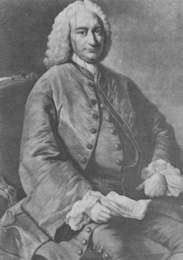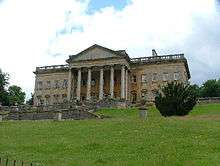Ralph Allen
| Ralph Allen | |
|---|---|
 | |
| Born |
1693 St Columb Major |
| Died |
29 June 1764 Bath |
| Resting place | Claverton Churchyard |
| Nationality | British |
| Occupation | Postmaster |
| Known for | Quarying of Bath Stone |
Ralph Allen (1693 – 29 June 1764) was an entrepreneur and philanthropist, and was notable for his reforms to the British postal system. He was baptised at St Columb Major in Cornwall on 24 July 1693. As a teenager he worked at the Post Office. He moved in 1710 to Bath, where he became a post office clerk, and at the age of 19, in 1712, became the Postmaster of Bath.[1] In 1742 he was elected Mayor of Bath.[2]
Involvement in the postal system
At the age of 27 Allen took control of the Cross and Bye Posts in the South West under a seven-year contract with the General Post Office, although he had no official title. At the end of this period he had not made a profit, only breaking even.[2] But he had the courage to continue – with breathtaking success.
Over the next few years he reformed the postal service. He realised that post boys were delivering items of mail along their route without them being declared and that this was lost profit. He introduced a "signed for system" that prevented the malpractice. He also improved efficiency by not requiring mail to go via London.
Ralph Allen's reputation grew and he took over more and more of the English postal system, signing contracts every seven years until he died aged 71. It is estimated that he saved the Post Office £1,500,000 over a 40-year period. He won the patronage of General Wade in 1715, when he disclosed details of a Jacobite uprising in Cornwall.[3]
Quarrying of Bath Stone
With the arrival of John Wood in Bath, Allen used the wealth gained from his postal reforms to acquire the stone quarries at Combe Down and Bathampton Down Mines.[2] Hitherto, the quarry masons had always hewn stone roughly providing blocks of varying size. The resulting uneven surface is known as "rubble" and buildings of this type – built during the Stuart period – are visible throughout the older parts of Bath.
The distinctive honey-coloured Bath Stone, used to build the Georgian city, made Allen a second fortune. The building in Lilliput Alley, Bath (now North Parade Passage), which he used as a post office, became his Town House and in 1727 he refronted the southern rubble wall, extended the house to the north and added a whole new storey. John Wood the Elder refers to this in his "Essay towards the future of Bath". Allen was extremely astute at marketing the qualities of Bath Stone and erected an elaborately ornate building a few feet to the north of his house to demonstrate its qualities. The extension (as Wood refers to it) has become known as "Ralph Allen's Town House" though whether it was designed by Wood is unproven and many local historians consider it unlikely.[4][5][6] Allen continued to live there until 1745, when he moved to Prior Park, and the townhouse became his offices.[7]

Allen had the Palladian mansion Prior Park built for himself (1742) on a hill overlooking the city, "To see all Bath, and for all Bath to see". He gave money and the stone for the building of the Mineral Water Hospital in 1738.
Allen had a summer home built in the English coastal town of Weymouth in Dorset, overlooking the harbour at number 2 Trinity street, opposite the Customs house. There is a plaque on the house to commemorate Allen. His Bath stone was used to build the Georgian style buildings in old Weymouth.
Commemoration
Ralph Allen is buried in a pyramid-topped tomb in Claverton churchyard, on the outskirts of Bath, which is the subject of a fundraising campaign to pay for its badly-needed renovation.[8]
His name is commemorated in Bath in Ralph Allen Drive which runs past his former home at Prior Park. Now a busy road from Combe Down village to Bath city centre, this was originally the route by which the stone from his quarries at Combe Down was sent on wooden sledges down to the River Avon. He is also remembered in Ralph Allen School, one of the city's state secondary schools. Prior Park College, a private school for 11- to 18-year-olds, is housed in Allen's former home and incorporates a boys' boarding house named Allen House.
The garden and Palladian bridge are cared for by the National Trust, who brought the garden back from dereliction in 1993.
The Ralph Allen CornerStone in Combe Down village opened in the autumn of 2013. This houses the archives of the Combe Down Heritage Society[9] and provides a community hub and information centre as part of the legacy of the project to infill the original stone mines underneath the village.[10]
Henry Fielding used Allen as the model for Squire Allworthy in the novel Tom Jones.[2]
References
- ↑ Staff, Frank (1966). The Penny Post, 1680–1918, p. 57. London: Lutterworth Press
- 1 2 3 4 "Ralph Allen Biography". Bath Postal Museum. Retrieved 12 September 2015.
- ↑ "Ralph Allen". Jane Austen Centre. Retrieved 12 September 2015.
- ↑ http://idox.bathnes.gov.uk/WAM/doc/BackGround%20Papers-237538.pdf?extension=.pdf&id=237538&location=VOLUME2&contentType=application/pdf&pageCount=1
- ↑ Holland.E. The kingson estate within the walled city of Bath, Blacket press 1992
- ↑ "Ralph Allen's House, Terrace Walk, Bath". Images of England. English Heritage. Retrieved 10 January 2009.
- ↑ "060219.Bath, A Room with a View". Bath Daily Photos. Retrieved 16 April 2009.
- ↑ "Mausoleum to Ralph Allen, in churchyard to south of St Mary's Church". Images of England. Retrieved 14 January 2008.
- ↑ http://combedownheritagesociety.wordpress.com/
- ↑ http://www.ralphallencornerstone.org.uk
Bibliography
| Wikisource has the text of the 1885–1900 Dictionary of National Biography's article about Ralph Allen. |
- Boyce, B. (1967). The benevolent man: a life of Ralph Allen of Bath.
- Peach, R.E.M. (1895). The life and times of Ralph Allen.
- Hopkins, A.E. (ed.) (1960) Ralph Allen's own narrative, 1720–1761
- Erskine-Hill, Howard (1975). 'Low-Born Allen': Ralph Allen (1693–1764) in: The Social Milieu of Alexander Pope.
- Davis, S. (1985). Ralph Allen: benefactor and postal reformer. [Bath Postal Museum booklet].
External links
- Ralph Allen at the National Portrait Gallery, London
- Allen, Ralph (1694-1764) Philanthropist at the National Register of Archives
- Combe Down Heritage Society
- Ralph Allen CornerStone
- Prior Park Landscape Garden, National Trust